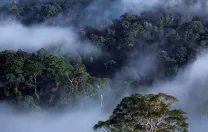The world was supposed to work this way: global warming would cause a burst of growth in tropical forests, and the trees would take up some carbon dioxide (CO2) from the atmosphere and sequester it in plant tissue. Recent studies of conditions in Amazon forests did indeed show accelerated growth rates. But data from two forests in the Center for Tropical Forest Science (CTFS) network reveal that just the opposite has happened; the growth rates of the majority of tree species have slowed dramatically in the past 25 years, suggesting we had better not count on this “carbon sink” to suck away our global-warming problems.
Kenneth J. Feeley, an ecologist and postdoctoral fellow at the Arnold Arboretum, is the lead author of a paper published last spring in Ecology Letters that reports on a study of data from the first two Forest Dynamics Plots established by CTFS, on opposite sides of the planet—one at Barro Colorado Island, Panama, the other at Pasoh, Malaysia. Commenting on his and his colleagues’ findings, Feeley says that “slower tree growth in tropical rain forests will have very important implications for both the global environment and economy.”
Global biodiversity may be diminished. All the animals that live in tropical forests “depend on plant productivity as a source of energy,” says Feeley. “Decreased growth will reduce the amount of energy available, which could reduce the number of animal species that these ecosystems can support.”
Slower growth may reduce timber available for logging, and logged forests may take longer to recover. “In order for loggers to maintain current yields,” says Feeley, “they will have to increase either the intensity of the logging or increase the area of forest that they log.”
Feeley imagines an unfortunate environmental spiral: “Reductions in tree growth may result in reduced rates of carbon uptake from the atmosphere, which, coupled with the extra emissions of CO2 from associated increases in logging and deforestation, could accelerate the increase of atmospheric CO2 and global warming, causing even further reductions in tree growth, and so on and so on.”
Another Harvard scholar who may find surprises in CTFS data is Paul R. Moorcroft, professor of biology and a maker of terrestrial bio sphere models. Such models indicate that human-induced increases in surface temperatures and rising levels of atmospheric CO2 during the coming century will cause profound changes in tropical forests around the globe and, indeed, says Moorcroft, “will cause a collapse of Amazonian tropical forests in the middle of this century.” The biosphere models used to make such predictions contain detailed mechanistic representations of biological processes that govern the composition and functioning of ecosystems, but, says Moorcroft, their ability to represent such things accurately—to predict key empirical metrics such as the dynamics of tree growth, for instance, or the rates at which carbon and water are exchanged between the tropical forest canopies and the atmosphere—have, so far, remained largely untested. “The measurements collected by CTFS researchers during the past two decades,” he says, are providing his lab “with a unique dataset for testing the abilities of terrestrial biosphere models to correctly capture the current composition, structure, and functioning of tropical forest ecosystems. We will be able to determine the accuracy of current model formulations and thus know how seriously we have to take their predictions about the long-term future of tropical forests.”
Much terra incognita remains to be explored. What accounts for the slowing of growth that CTFS data revealed to Feeley and his colleagues? Even though increases in atmospheric CO2 provide fertilizer that can stimulate growth by aiding photosynthesis, they found that over the period of the study, the number of rainy days had increased at both sites, meaning that less sunlight was available to fuel photosynthesis. Moreover, nighttime temperatures had increased at the sites, and higher temperatures mean higher respiration rates. When trees have less energy coming in and more going out, they have less for growth, as appears to have happened in these two forests.
“Temperature and CO2 may operate in opposite directions on tree growth,” says Stuart Davies, Ph.D. ’96, a coauthor of the paper. “That’s what we’re arguing, but we have to be honest and say that we don’t know the answer yet.”
Davies is the director of CTFS. (Heretofore headquartered in Ancon, Panama, the center and Davies move this September to the Harvard University Herbaria in Cambridge. The Asian operations of CTFS are overseen by the Arnold Arboretum.) A former graduate student of Bullard professor emeritus Peter Ashton, Davies is a tropical ecologist and taxonomist who has done fieldwork in the tropics and was associate professor at the Institute for Biodiversity and Environmental Conservation, Universiti Malaysia Sarawak. He has studied the factors that control the regeneration of tropical forests after logging and agriculture and, in collaboration with Malaysian and U.S. ecologists and economists, he has worked to develop new techniques to assess and value biodiversity.
“We don’t yet know,” he says, “whether or not this slowing of growth is a global process, whether or not the Amazon might operate differently from other forests, how long present conditions will last. We don’t have enough information. But the beauty of having 20 CTFS research plots is that they will give us unparalleled power to learn more.”







